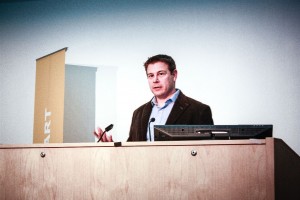Low Carbon Living

Deyette said he intended to give the audience a closer look at his new book, “Get Cooler, Smarter: Practice steps for low carbon living.”
The speaker stressed that he was not trying to coax anyone into changing his or her lifestyle to a completely ecofriendly one, but to show that small changes can be crucial for keeping our escalating carbon levels low.
Deyette introduced the book as a practical and helpful guide to low carbon living. His course of action was to pull information from the book and provide a step by step analysis of the research Deyette and his colleagues conducted.
Their results showed that most people believe their tiny impact will not make a difference.
According to Deyette, this is false. He said that changing minor routines, such as recycling bottles and cans, can make a pivotal difference statistically.
Deyette explained that it is up to us to change our lifestyles to low carbon living and to advocate to others how important it is to switch to renewable, clean air technology.
The presentation consisted mostly of charts, facts, and figures. The main question Deyette asked was “What can we do?”
He said that the national average of an individual driving a car per year causes seven tons of CO2 to disperse in the air. Deyette said that, from an economic standpoint, the money it will cost to get a newer car will pay itself off in the long run.
Deyette displayed a chart showing the amount of carbon placed into the air each year. Twenty eight percent of carbon is displaced from transportation, 17 percent is distributed from heating and cooling, 15 percent is from appliances, 14 percent from food, and 26 percent is from daily spending.
On average, most energy use is from light bulbs. Small things, such as leaving a power cord plugged into the wall when the appliance is not on also contribute.
There is power still running through that cord on standby and this could be the minor increase in the electric bill each month. These small actions can save money each month and year.
For more information, visit www.coolersmarter.org.
